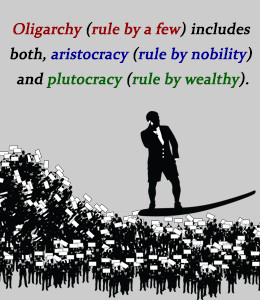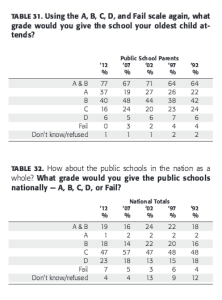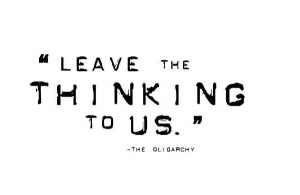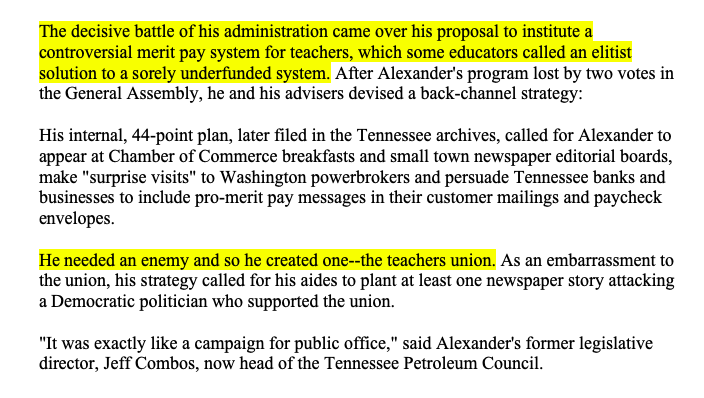Who decided it was best to have an education reform oligarchy set the strategy for school improvements? This oligarchy is made up of politicians, business-heads, and philanthropic venture capitalists that are transforming our public education system. Did we decide we wanted these people to change our schools for us?
 When did Americans decide that governing by the few was acceptable?
When did Americans decide that governing by the few was acceptable?
Who’s in this elite group?
The complete list of those who set the agenda for education reform remains a bit of a mystery. But enough of the oligarchy have surfaced over the years to form an accurate, yet incomplete, picture.
One thing is certain, the “iron law of oligarchy” rings true in the case of the National Governors Association (NGA). The law…
“…states that when organizations attain a certain level of complexity they inevitably give way to an oligarchy of elite control — elite domination. This phenomenon is due to the rise of politically sophisticated social elites within the organization as well as the organization’s need to maintain consistent command and control administrative governance in order to attain its goals.”
The approximate time when our modern-day education reform oligarchy was formally established is somewhere between 1982 and 1986. But it doesn’t really matter. The fact is, it is real and “They” (whoever they are) are still in control. NGA was, and remains, one reform tool central to their work. As then Secretary of Education William (Bill) Bennett told the governors at the NGA meeting in 1986 at Hilton Head, South Carolina,
“…you are in charge of schools in your states, and when you decide to act you can act.”
And the association, with counsel, took actions to transform the public education system based on a vision provided by those that see nothing wrong with a small ruling class dictating the change they have decided will work for us.
Here is some insight into their reasoning:
From Mr. Lewis Branscomb (in 1986) as the chief scientist for IBM who headed the task force on teaching for the Carnegie Foundation;
“We hear a lot about a knowledge-based economy. I think it’s important to appreciate that moving into a knowledge-based economy, if that’s what it takes to be competitive, that we can’t expect the smokestack industries to create the new employment.
Then we have to ask, “What is industry in a knowledge-based economy?” The answer is the education industry. The next question you ask is, “Well, how competitive is the education industry?” A question Governor Lamm asked in a very interesting paper I read. You have to say our education industry — to be sure a public sector industry, nonetheless an industry –is not competitive today. So, if our economy is going to be competitive, the education industry has got to be competitive.
I think the key to engaging a long-term interest and commitment of companies is the adoption of a reform strategy, like that proposed by the Carnegie task force and the Governors’ task force…
…parents are a declining percentage of the voting population in this country. It will not be sufficient to have just the parents in favor of better schools. We have got to have the retired population understanding that their future Social Security payments depend upon the earnings of kids who are now going into school.”
Targeting public opinion? We find a consistent difference of opinion between how parents see their own school —based on their experiences and knowledge of their school— and how they view the public schools in the nation. Is this a difference between what they see and hear for themselves and what the marketing for the reform strategy has produced?
From Marc Tucker (in 1986) as executive director of the Carnegie Forum on Education and the Economy;
“When the Carnegie Forum Task Force began its work, we knew that the Governors were the key to the necessary revolution in school policy.
The results are clear. The Governors and the members of the Carnegie Task Force are of one mind on the issues and on strategy. The Carnegie Forum stands ready to join with each of you and with the National Governors’ Association in implementation of our common agenda.
We now know that the Governors of this country are solidly committed to a new political compact in education and to a set of powerful strategies for completing that compact.”
Like-minded leaders targeting the public? The focus of the 1986 meeting was on what was being dubbed “the 1991 Education Report” which outlined their five-year plan.
From Lou Harris (in 1986), of Lou Harris and Associates polling organization hired by the Carnegie Foundation to assess the popularity of the Carnegie Forum report A Nation Prepared, these observations of his polling results;
“In this study we just concluded for the Carnegie Forum on Education and the Economy…the clear mandate is for nothing less than complete and comprehensive overhaul of the entire public education system….
What you do today will be national policy tomorrow, and a generation from now, it’s my view, that a grateful nation will give you its thanks for what you have done here this week.”
And the predictions from the chair of the NGA (in 1986), then Governor Lamar Alexander (who now leads the charge as chair of the Senate HELP – Health, Education, Labor, Pension- committee)…
“If you look over the horizon and see a big cloud of dust, it’s not likely to be the Russians or the buffaloes coming; it’s likely to be the Governors coming to save the schools, and coming in virtually every state.”
In a 1986 New York Times article, the author observed…
“…what this political process has not been able to address thus far is how to move from the ‘input’ to the ‘output,’ or how the increased resources will be translated into students who can meet the higher standards.”
A couple of things are noteworthy about that statement; this was a political process, it was meant to move us from a focus on inputs to one of outputs (outcome-based education reform), and there was talk of increased resources. Talk.
Today we know that education budgets were cut dramatically during our Great Recession, funding remains inequitable and downright inadequate in many places, costs for testing with ever-changing new “higher” standards and all the new curriculum materials that go with them has driven up education costs dramatically while teachers still struggle with supplying the classroom materials they need. Outputs in the face of the wrong inputs? Silliness, or, the strategy?
By 1990, the teachers’ unions also had set a new agenda …
“… to not only protect the job-related interests of their members but also ensure the success of the education industry.”
Doing the bidding of the oligarchy? Following the guiding principle to support the education reform market?
If success of the education industry is how education is tied to the economy then the strategy our rulers put forth makes sense. Private profits went up. Public dissatisfaction with school reforms went up and new education industry products appeared — giving us a choice, providing competition. Who decided this was the choice we needed?
The Reading Wars. The Math Wars. Someone always profits from wars.
 The education reform wars still continue to be a political process wrought with blunders because the American education reform oligarchy —the few that rule—don’t listen to the many that have a good solid base of experience and knowledge. We are many.
The education reform wars still continue to be a political process wrought with blunders because the American education reform oligarchy —the few that rule—don’t listen to the many that have a good solid base of experience and knowledge. We are many.
But back to the governors and their association, today, do they or we know what the actual recommendations were? Do we know if, in the 80’s, the governors were listening to the testimony of those outside their relatively small circle of influence? Time for results?
Do the ruling elite understand what was in the original plans? Many were present then and still ruling now. They should know. But is their focus on serving the common good by providing quality education to all children, or, supporting the economy by supporting the education industry? These things have not proven to be one-in-the-same.
I don’t think the public knows what was in the original plans. If we did, I’m pretty sure we wouldn’t be doing what we are doing to the institution of public education. We aren’t reforming; we are allowing systemic destruction to advance while the industry profits.
The education reform agenda, that has dominated the U.S. for three decades, was set for us by the education oligarchy.
We should decide if we wish to continue with their plan and strategies.
Decide: Should education reform continue as a political process or a school improvement process? Must we take control of both to set things right?




